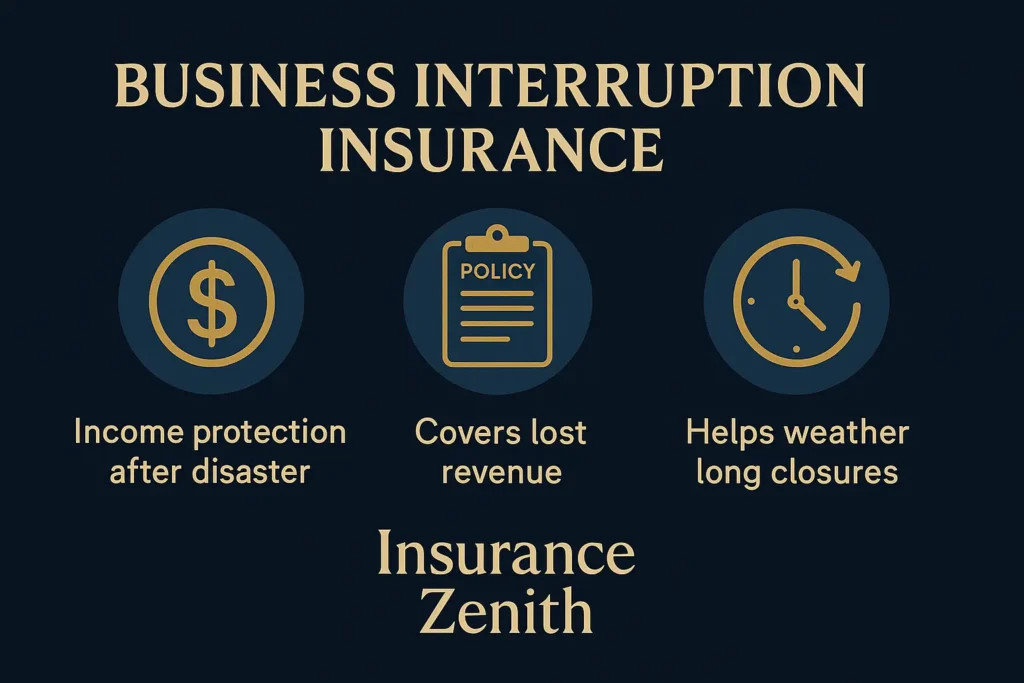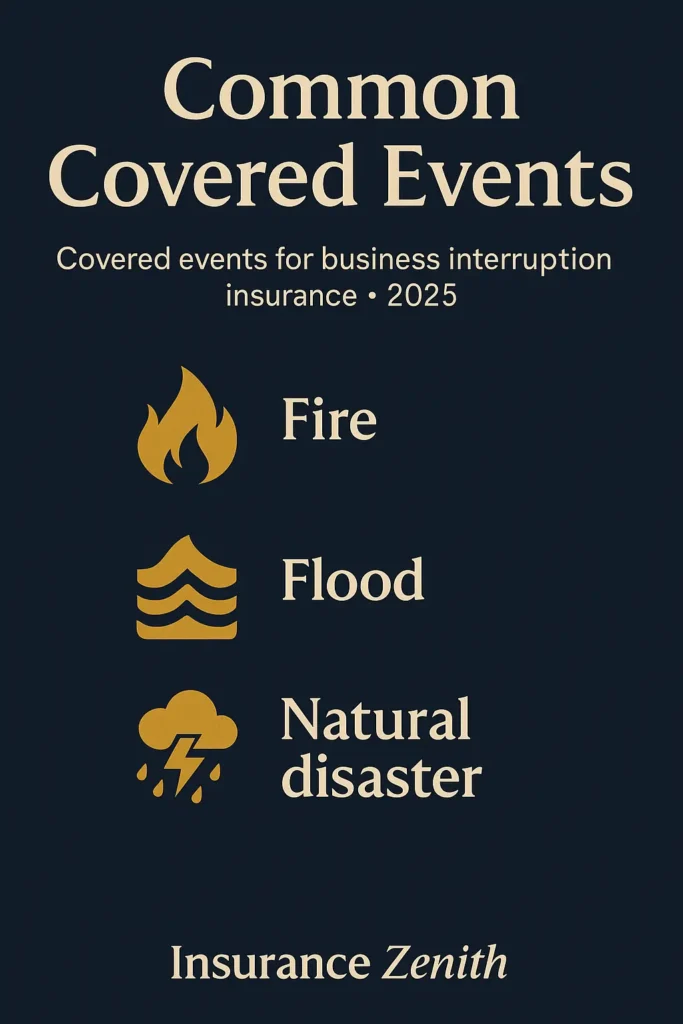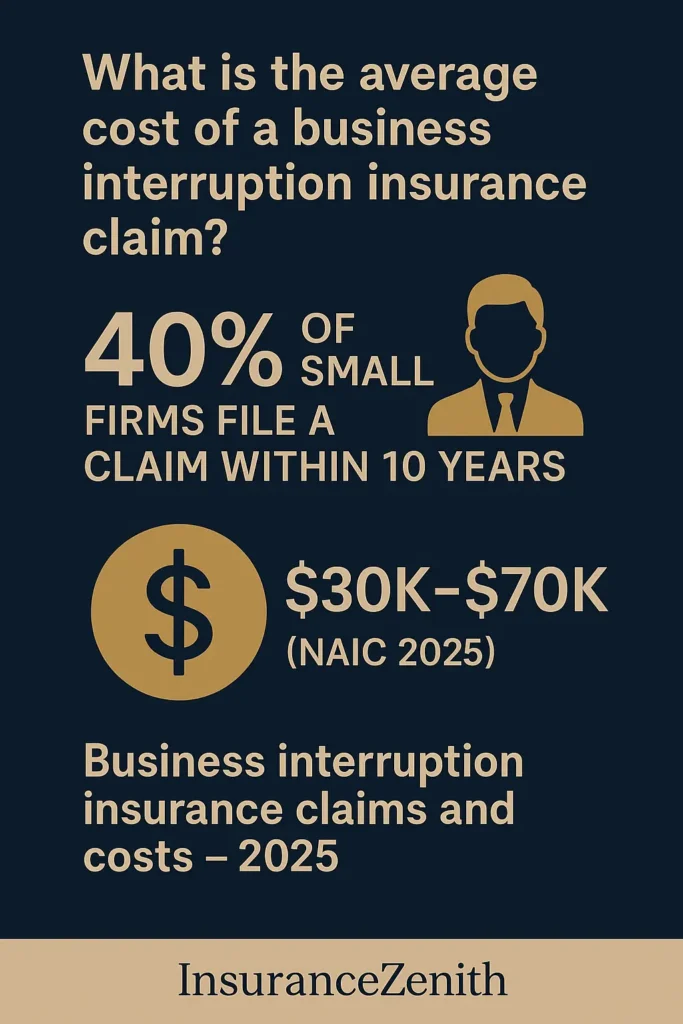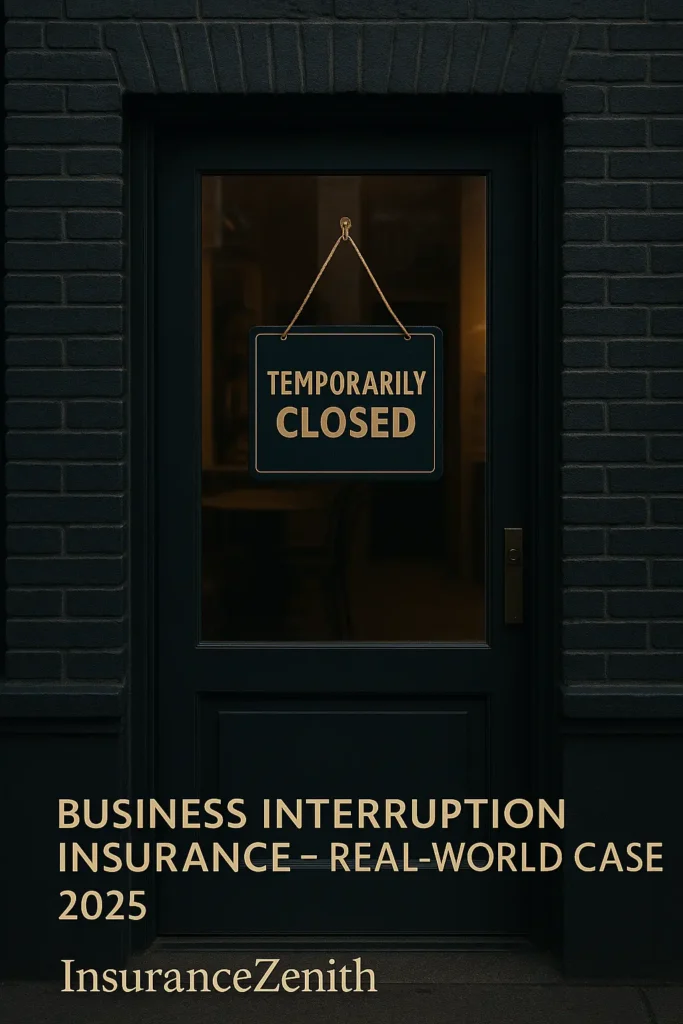
Picture this: your thriving coffee shop gets hit by a kitchen fire at 7 AM on a busy Monday. While your commercial property insurance covers the physical damage, what about the $3,000 you lose every day your doors stay closed for three months? That’s where business interruption insurance becomes your financial lifeline.
Recent data from the Insurance Information Institute shows that 75% of small businesses lack adequate business interruption insurance coverage. Even more alarming: according to the Federal Emergency Management Agency, 40% of small businesses never reopen after a major disaster.
Here’s what smart business owners discovered in 2025: business interruption insurance costs between $40-130 monthly but can prevent total business failure during extended closures. This specialized coverage replaces lost income and covers continuing expenses when covered disasters force temporary shutdowns.
Essential Coverage Elements:
- Lost revenue replacement during forced closures
- Continuing expense coverage (rent, payroll, loans)
- Extra costs for temporary business operations
- Protection against most natural disasters and covered perils
On This Page
1. What Business Interruption Insurance Actually Covers
Business interruption insurance functions as income replacement when covered disasters prevent normal operations. Unlike standard commercial property coverage that fixes physical damage, this specialized protection addresses the financial bleeding that occurs during closure periods.
Core Coverage Components
The insurance industry defines business interruption insurance as coverage that compensates for lost net income and continuing expenses when physical property damage forces operational suspension. According to The Hartford’s 2025 business insurance report, this coverage has become increasingly critical as extreme weather events increase by 23% annually.
Your business interruption insurance policy typically covers three main areas: lost profits based on historical earnings, continuing operational expenses that don’t stop during closure, and extra expenses incurred to minimize downtime. For comprehensive protection understanding, review our complete business insurance guide.
1.1 Lost Revenue and Profit Protection

Business income calculations rely on your company’s historical financial performance and reasonable future projections. Insurance adjusters analyze your previous 12-24 months of financial records to establish baseline earnings patterns.
Revenue Calculation Methods:
- Historical average monthly profits from past two years
- Seasonal adjustment factors for peak and slow periods
- Projected growth rates based on business trends
- Market conditions affecting your industry sector
The National Association of Insurance Commissioners reports that proper revenue documentation increases claim settlements by an average of 34%. Maintain detailed financial records including profit/loss statements, tax returns, and bank deposits.
Professional service businesses typically see faster claim processing due to simpler income streams, while retail and restaurant operations require more complex calculations involving inventory turnover and seasonal variations.
1.2 Continuing Expenses Coverage During Closure
Your business bills don’t pause during disaster recovery. Business interruption insurance covers specific continuing expenses that persist regardless of operational status.
Covered Continuing Expenses:
- Commercial rent and mortgage payments
- Insurance premiums and policy renewals
- Equipment lease payments and financing obligations
- Key employee salaries and essential staffing costs
- Business loan payments and interest obligations
- Property taxes and licensing fees
According to Embroker’s 2025 cost analysis, continuing expenses typically represent 60-75% of total business interruption claims. Smart coverage planning ensures adequate limits for these ongoing obligations.
For businesses with significant operational complexity, consider specialized professional liability insurance alongside your business interruption coverage for comprehensive protection.
1.3 Extra Expense Coverage for Emergency Operations
Extra expense coverage pays additional costs incurred to minimize business disruption and accelerate recovery. This specialized component often determines whether businesses bounce back quickly or struggle for months.
Typical Extra Expenses Include:
- Temporary business location rental and setup costs
- Expedited equipment delivery and installation fees
- Overtime wages for restoration and cleanup work
- Emergency marketing to notify customers of changes
- Temporary staffing and consultant fees
Real-world example: A manufacturing company suffered warehouse fire damage in Phoenix. Their business interruption insurance covered $47,000 in extra expenses for temporary warehouse rental, allowing them to maintain 80% production capacity during six-month restoration. Without this coverage, they would have lost major contracts worth $340,000.
The Small Business Administration emphasizes that businesses utilizing extra expense coverage recover 40% faster than those relying solely on basic business income protection.
2. How Business Interruption Claims Work Step-by-Step
Filing successful business interruption claims requires systematic documentation and understanding of the adjustment process. Unlike simple property claims, income loss claims involve complex financial analysis and projections.
2.1 Immediate Post-Disaster Response Protocol

Time sensitivity defines business interruption claim success. The first 72 hours after a covered loss significantly impact your ultimate settlement amount and recovery timeline.
Critical First Steps:
- Ensure immediate safety and secure damaged property
- Contact your insurance carrier within 24 hours
- Document all physical damage with photos and videos
- Begin collecting financial records and documentation
- Create detailed inventory of damaged business property
- Preserve all receipts for emergency expenses and temporary measures
According to Chubb’s claims processing data, businesses that initiate claims within 24 hours receive settlements 28% faster than those delaying initial contact.
Start gathering historical financial documents immediately. You’ll need profit/loss statements, tax returns, bank records, and payroll documentation to support your income loss calculations. For restaurants and retail businesses, review our specialized small business insurance cost guide for industry-specific claim requirements.
2.2 Required Documentation and Financial Records
Business interruption adjusters require extensive financial documentation to verify pre-loss income and calculate fair compensation. Incomplete records delay settlements and may reduce claim payments.
Essential Financial Documentation:
- Business tax returns for previous three years
- Monthly profit and loss statements for 24 months pre-loss
- General ledger and accounting records with transaction details
- Bank statements showing deposits and business income patterns
- Payroll records including employee compensation and benefits
- Supplier contracts and major customer agreements
The Insurance Services Office reports that 67% of business interruption claim disputes involve inadequate financial documentation. Organize records chronologically and provide both digital and physical copies to expedite the adjustment process.
For technology-dependent businesses, consider how cyber insurance coverage complements your business interruption protection against digital disruptions.
2.3 Working with Adjusters and Forensic Accountants
Complex business interruption claims often involve specialized professionals who understand income loss calculations and business valuation principles.
Professional Claim Team Roles:
- Property Adjuster: Assesses physical damage and repair requirements
- Business Interruption Adjuster: Calculates income loss and continuing expenses
- Forensic Accountant: Analyzes financial records and validates income projections
- Industry Expert: Provides market analysis for specialized business types
Maintain professional relationships with your adjustment team. Respond promptly to information requests, ask questions about unclear procedures, and document all communications. Consider hiring your own forensic accountant for claims exceeding $100,000 to ensure fair settlement calculations.
The American Institute of CPAs indicates that independent forensic review increases average settlements by 12-18% for complex business interruption claims.
3. Coverage Costs and Premium Calculation Factors
Business interruption insurance premiums vary significantly based on industry risk, revenue levels, and geographic location. Understanding cost factors helps optimize coverage while managing insurance budgets effectively.
3.1 Premium Cost Ranges by Business Type

According to TechInsurance’s 2025 premium survey, business interruption insurance premiums typically range from $40-130 monthly for small businesses, with significant variations by industry sector.
Industry Premium Ranges (Monthly):
- Professional services (law, accounting, consulting): $40-70
- Retail and e-commerce operations: $60-95
- Restaurants and food service: $85-130
- Manufacturing and industrial: $95-145
- Healthcare and medical practices: $70-110
These costs represent business interruption coverage added to comprehensive business owner’s policy packages. Standalone business interruption policies typically cost 15-25% more than bundled coverage options.
Geographic location significantly impacts premiums. Businesses in hurricane-prone coastal areas pay 30-50% higher rates than those in low-risk inland regions. Similarly, earthquake zones in California see premium increases of 25-40% compared to seismically stable areas.
3.2 Key Factors Affecting Insurance Premiums
Insurance carriers evaluate multiple risk factors when calculating business interruption premiums. Understanding these variables helps businesses optimize coverage costs through risk management investments.
Primary Premium Calculation Factors:
- Annual business revenue and profit margins
- Industry classification and operational risks
- Geographic location and natural disaster exposure
- Building construction type and fire protection systems
- Claims history and risk management practices
Revenue levels directly correlate with premium costs since higher-earning businesses require more coverage. A restaurant generating $50,000 monthly typically pays 40-60% higher premiums than one earning $25,000 monthly.
Building characteristics significantly impact costs. Businesses in newer buildings with sprinkler systems, fire alarms, and security systems qualify for premium discounts ranging from 10-25%. For detailed cost analysis by business type, explore our comprehensive business insurance cost breakdown.
3.3 Proven Strategies for Reducing Premium Costs

Smart risk management and coverage optimization can substantially reduce business interruption insurance costs without sacrificing essential protection.
Effective Cost Reduction Methods:
- Bundle with Business Owner’s Policy for 10-15% savings
- Increase deductibles from $1,000 to $5,000 for 20-30% premium reduction
- Install fire suppression and security systems for safety discounts
- Maintain clean claims history to qualify for experience credits
- Pay annual premiums instead of monthly to avoid installment fees
The National Fire Protection Association reports that businesses with comprehensive fire protection systems experience 45% fewer total losses and qualify for significant premium discounts.
Consider higher deductibles carefully. While a $5,000 deductible reduces premiums by 25-30%, ensure your business can handle this expense during a claim. Emergency fund planning should account for deductible amounts plus initial recovery costs.
4. Understanding Policy Exclusions and Limitations
Business interruption insurance contains specific exclusions and limitations that can create coverage gaps. Recognizing these restrictions helps businesses plan additional protection for unaddressed risks.
4.1 Standard Policy Exclusions
Modern business interruption policies exclude numerous perils that don’t involve direct physical property damage. These exclusions evolved after significant industry losses from cyber attacks and pandemic-related shutdowns.
Common Coverage Exclusions:
- Pandemic and communicable disease outbreaks (COVID-19 type events)
- Cyber attacks and digital security breaches
- Flood and earthquake damage (require separate policies)
- Government-mandated shutdowns without property damage
- Utility service interruptions without physical damage to utility property
- Voluntary business closure decisions
The Insurance Information Institute notes that pandemic exclusions became standard after the 2003 SARS outbreak cost insurers over $16 million in business interruption claims. Post-COVID, these exclusions are now universal across commercial policies.
For technology-dependent businesses, cyber-related interruptions represent significant unaddressed risks. Complement your coverage with specialized cyber insurance protection to address digital disruption scenarios.
4.2 Coverage Limitations and Waiting Periods
Even when coverage applies, business interruption policies contain limitations that affect claim settlements and coverage duration.
Key Policy Limitations:
- Waiting periods of 48-72 hours before coverage activation
- Maximum coverage periods ranging from 12-36 months
- Requirement for complete business shutdown (partial interruptions may not qualify)
- Documentation requirements for all claimed income and expenses
- Geographic restrictions limiting covered property locations
According to Marsh’s risk management analysis, 34% of business interruption disputes involve waiting period misunderstandings. Most policies require complete cessation of business operations for the minimum waiting period before coverage activates.
Partial business interruptions present complex coverage scenarios. If your restaurant can operate at 50% capacity due to kitchen damage, some policies pro-rate coverage while others require total shutdown to trigger benefits.
4.3 Addressing Coverage Gaps with Supplemental Insurance
Comprehensive business protection requires addressing exclusions through specialized coverage options. Strategic gap-filling protects against modern business risks not covered by traditional policies.
Supplemental Coverage Options:
- Cyber liability insurance for digital disruption and data breaches
- Flood insurance through National Flood Insurance Program
- Equipment breakdown coverage for mechanical and electrical failures
- Utility interruption endorsements for power and service outages
- Contingent business interruption for supplier and customer shutdowns
The Cybersecurity and Infrastructure Security Agency reports that 43% of cyber attacks target small businesses, with average downtime exceeding 23 days. Traditional business interruption policies don’t address these increasingly common scenarios.
Evaluate your specific risk profile when selecting supplemental coverage. Coastal businesses prioritize flood protection, while technology companies focus on cyber liability coverage. Review our detailed cyber insurance coverage guide for digital risk assessment strategies.
5. Industry-Specific Business Interruption Considerations
Different industries face unique risks and recovery challenges that influence business interruption insurance needs. Tailored coverage approaches address sector-specific vulnerabilities and operational requirements.
5.1 Restaurant and Food Service Industry
Restaurants face elevated business interruption risks due to fire hazards, health code compliance, and perishable inventory dependencies. The National Restaurant Association reports that food service businesses experience 60% longer recovery periods than average commercial operations.
Restaurant-Specific Coverage Needs:
- Spoilage coverage for perishable inventory losses
- Extra expense coverage for temporary kitchen rental
- Ordinance and law coverage for health code compliance upgrades
- Equipment breakdown protection for refrigeration and cooking systems
- Lost income calculations including seasonal revenue variations
Food safety incidents present unique challenges. Even minor contamination events can trigger health department closures lasting weeks, making adequate business interruption limits critical for restaurant survival.
Consider how workers compensation requirements integrate with your business interruption planning, especially for restaurants with significant employee exposure to kitchen hazards.
5.2 Manufacturing and Industrial Operations
Manufacturing businesses face complex supply chain dependencies and specialized equipment requirements that influence business interruption coverage needs and recovery timelines.
Manufacturing Industry Considerations:
- Extended equipment replacement timelines for specialized machinery
- Supply chain disruption coverage for critical component suppliers
- Skilled workforce retention during extended shutdowns
- Quality control and certification requirements for resumed operations
- International supply chain vulnerabilities and logistics delays
According to Manufacturing USA’s resilience study, industrial businesses require average recovery periods of 8-14 months compared to 3-6 months for service-based operations.
Custom machinery replacement can take 12-18 months, making adequate coverage limits and extended restoration periods essential for manufacturing operations. Factor these extended timelines into your coverage calculations.
5.3 Professional Services and Technology Companies
Professional services and technology businesses face unique business interruption scenarios involving data recovery, client relationship preservation, and remote work capabilities.
Professional Services Coverage Priorities:
- Data recovery and system restoration costs
- Client relationship preservation and communication expenses
- Temporary office space and technology infrastructure
- Professional liability coverage during disrupted service delivery
- Key employee retention during extended interruptions
The Bureau of Labor Statistics reports that professional services businesses lose an average of $12,000 per day during technology-related interruptions, making quick recovery essential for client retention.
Technology-dependent professional services should evaluate how professional liability coverage coordinates with business interruption protection during service delivery disruptions.
Conclusion
Business interruption insurance represents critical financial protection that can determine whether your business survives or fails after a major disaster. With average claim settlements exceeding $85,000 according to recent industry data, this coverage provides essential income replacement and expense coverage during forced closures.
Key Protection Elements: Business interruption insurance costs $40-130 monthly but prevents catastrophic financial losses during extended shutdowns. Coverage requires physical property damage to trigger benefits, making it essential to understand exclusions for cyber attacks, pandemics, and voluntary closures. Proper documentation and adequate coverage limits ensure successful claim settlements.
Smart business owners combine business interruption coverage with comprehensive business insurance protection to address multiple risk scenarios. Consider industry-specific needs, geographic risks, and operational dependencies when designing your coverage strategy.
Action Steps for Business Owners: Calculate coverage needs based on monthly revenue plus continuing expenses, then factor in realistic recovery timelines for your industry. Maintain detailed financial records, implement risk management practices, and consider supplemental coverage for excluded perils like cyber attacks and floods.
The investment in proper business interruption coverage pays dividends when disaster strikes. Don’t let a recoverable incident become a permanent business failure due to inadequate income protection planning.
FAQ
What is an example of a business interruption insurance claim?
A manufacturing company in Phoenix suffered a warehouse fire that damaged their facility. Their business interruption insurance covered $47,000 in extra expenses for temporary warehouse rental, allowing them to maintain 80% production capacity during the six-month restoration period. Without this coverage, they would have lost major contracts worth $340,000.
The claim included three main components:
Lost revenue replacement: Income lost during the forced closure
Continuing expenses: Rent, payroll, loan payments that continued despite closure
Extra expenses: Temporary warehouse rental, expedited equipment delivery, overtime wages
According to the document, businesses utilizing extra expense coverage recover 40% faster than those relying solely on basic business income protection.
External Resource: For detailed claim examples and case studies, visit the Insurance Information Institute’s Business Interruption Claims Guide which provides comprehensive real-world scenarios across different industries.
How much does business interruption insurance cost?
Business interruption insurance costs between $40-130 monthly for small businesses, with significant variations by industry:
Monthly Premium Ranges by Industry:
Professional services (law, accounting, consulting): $40-70
Retail and e-commerce operations: $60-95
Restaurants and food service: $85-130
Manufacturing and industrial: $95-145
Healthcare and medical practices: $70-110
Cost factors include:
Annual business revenue and profit margins
Industry classification and operational risks
Geographic location (coastal areas pay 30-50% more)
Building construction type and fire protection systems
Bundling with a Business Owner’s Policy provides 10-15% savings compared to standalone coverage.
What is the most common cause of business interruption?
Fire damage represents the most common cause of business interruption claims, particularly affecting restaurants and manufacturing facilities. Kitchen fires in restaurants and electrical fires in manufacturing operations frequently trigger extended closures.
Other leading causes include:
Natural disasters (storms, hurricanes, flooding)
Equipment breakdown and mechanical failures
Cyber attacks (though often excluded from traditional policies)
Utility service interruptions
Government-mandated closures
The document notes that extreme weather events have increased by 23% annually, making natural disaster-related interruptions increasingly common. However, the COVID-19 pandemic highlighted gaps in coverage, as most policies now exclude communicable disease outbreaks.
What are the 4 main types of business insurance policies?
The four main types of business insurance policies are:
General Liability Insurance: Protects against customer injuries and third-party property damage claims
Commercial Property Insurance: Covers buildings, equipment, inventory, and business personal property
Workers’ Compensation Insurance: Mandatory in 49 states, covering employee injuries and illnesses
Professional Liability Insurance: Protects service providers against claims of errors, omissions, or negligence
Additional essential coverage includes:
Business interruption insurance (income replacement during closures)
Cyber liability insurance (43% of small businesses now carry this)
Commercial auto insurance (required for business vehicles)
Many businesses bundle these into a Business Owner’s Policy (BOP) for 15-25% premium savings.
External Resource: The Small Business Administration’s Insurance Guide provides detailed explanations of all business insurance types and requirements.
What qualifies as business interruption?
Business interruption requires physical property damage that forces suspension of normal operations. The key qualification is that a covered peril must cause direct physical damage to your business property or deny access to your premises.
Qualifying events include:
Fire, explosion, or storm damage to your building
Equipment breakdown that halts operations
Natural disasters affecting your business location
Civil authority orders preventing access due to property damage
Events that typically DON’T qualify:
Pandemic-related closures (universally excluded post-COVID)
Cyber attacks without physical damage
Voluntary business closure decisions
Government shutdowns without property damage
Utility interruptions without physical damage to utility property
Most policies require complete cessation of business operations, not partial interruptions. The document notes that 34% of business interruption disputes involve misunderstandings about these requirements.
How to prove a business interruption claim?
Proving a business interruption claim requires extensive financial documentation. The Insurance Services Office reports that 67% of claim disputes involve inadequate financial documentation.
Essential documentation includes:
Business tax returns for previous three years
Monthly profit/loss statements for 24 months pre-loss
Bank statements showing income patterns
Payroll records and employee compensation details
Supplier contracts and major customer agreements
Photos/videos documenting all physical damage
Critical timeline requirements:
Contact your insurance carrier within 24 hours
Begin collecting financial records immediately
Document all emergency expenses and temporary measures
Maintain detailed records of all recovery costs
The document emphasizes that proper revenue documentation increases claim settlements by an average of 34%. Businesses that initiate claims within 24 hours receive settlements 28% faster.
